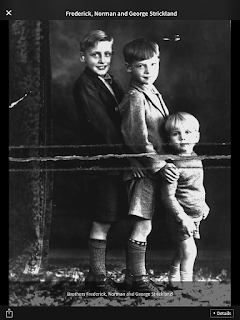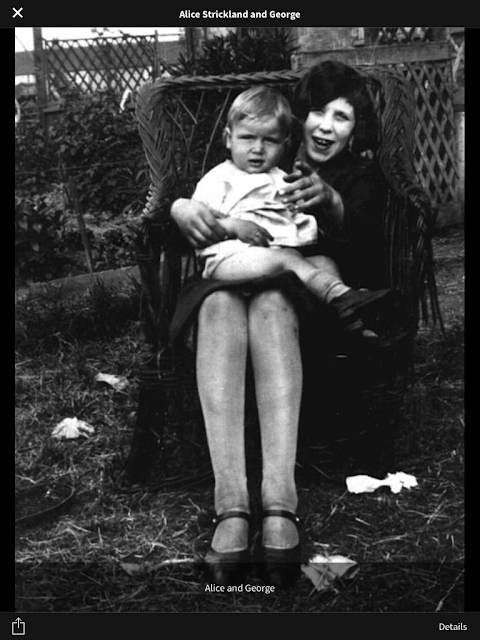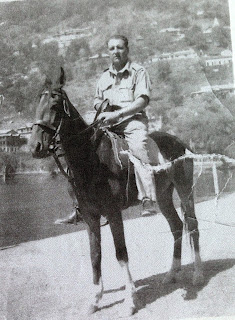Several years ago I was reading an article in the Cornish Family History magazine about crime in the Hayle area by John Higgans when the name of John Stickland caught my eye. It was a report of the forthcoming inquest to be held in regard to the murder of 3 year old Maria Stickland by her father John Stickland of Angarrack. There are some things that we would rather not have in the family and a murderer is certainly one of them, I went straightaway to check my records and to see in which way John was related to me and discovered that he was either a brother of my great- great grandfather or a cousin, I preferred the cousin option, the more distance the better!
I decided to get in touch with Mr. John Higgans who has helped me many times in the past and he confirmed my assumption that it was the cousin, John Stickland born 12th March 1837 the son of William Stickland and Ann Michell. He also very kindly enclosed a copy of the inquest report from the Times of May 1868 which shed a completely different light on the matter. John’s wife had died of consumption and was still lying unburied in her coffin when John overcome with grief slit the throat of his three year old daughter and then tried to take his own life by slitting his own throat, quite a tragedy. John was discovered before death came and restored to life. Mr. Higgans also informed me that a report of the trial could be found in the Cornish Times of August 1868.
I wrote to the Cornish Studies Library in Redruth but unfortunately their microfilm copy for that year was missing, they gave me the address of the British Newspaper Library in London, but once again I was disappointed to hear that the copy I wanted was missing. I wrote once more to the Cornish Studies Library and the Librarian was very helpful in looking in the Royal Cornwall Gazette and the West Briton and Cornwall Advertiser of the same dates and in both she found a complete three column report of the trial!
From the report I was able to find out even more information about the family, especially the interesting fact that John was married to his cousin Wilmot Stickland the sister of my great- great grandfather and that Wilmot’s mother Grace Stickland nee Morsehead was also living with them as well as two children from a previous marriage of Wilmot, Elizabeth Grace Miles and Thomas John Miles.
The undercurrents of the report of the trial are very interesting, John seemed to be very depressed because he didn’t have any money to bury his wife and his friends had all abandoned him, a neighbour who had known the family for many years, Edward Stephens, seemed very surprised that he didn’t have anything to sell, he asked John what had happened to his gold watch and his gold stick and the deeds to his property and he said that it was all gone. He seemed to think that his wife’s family and the Mile’s family had combined to deprive him of that which he should have. Apparantly after the death of Thomas Miles the first husband of Wilmot Stickland £1,000 was left for his son, what happened to all this money in the short space of four years is a great mystery? John also told Edward Stephens that the first husband’s children where to have his wife’s money and that there was nothing for his daughter but £60 in debt. Stephens also inferred to insanity in the family, an uncle of John who was in an asylum and his grandmother who was dement before her death, (how many more skeletons are in the cupboard?) but on cross examination it turned out that both had been of good mind in younger years.
The Doctor informed the court that John had been under treatment for several months for problems with his liver and stomach and that this ailment could cause depression which combined with the decline and death of his wife could have led to a temporary loss of his mind, In fact even though John was a boiler maker by trade his mother-in-law Grace Stickland informed the court that due to sickness he had been out of work for several weeks. This would also have made John depressed and could account for his lack of funds, in those days our ancestors didn’t have unemployment benefits and the National Health Service.
Grace Stickland testified as follows: “I live at Angarrack, in the same house that was occupied by the prisoner, and my daughter lives with me (this was a younger daughter called Elizabeth). The prisoner’s wife was my daughter, and the prisoner himself is a nephew of mine. On Sunday the 1st of May I had some conversation with him about his wife’s funeral. He asked if we should bury her on the Monday, and I replied that I should like to get the children’s mourning, and that I would rather the funeral should take place on the Tuesday. He went upstairs; I never saw him afterwards till the 23rd of May at Camborne, before the Magistrates. I heard no noises during the night. The next morning I went to inquire about some black cloth in the prisoner’s room. The servant sent the child Elizabeth Grace into the room for it, and directly after the child rushed out shrieking, saying there is blood and a knife in Jack’s room. This was the name by which they called him. My daughter was first married to a man named Miles, and on his death she administered to his effects. The prisoner was very fond of his child, the deceased.” Cross-examined Grace replied, “The prisoner was not naturally a strong man, though a big man. He used frequently to bleed at the nose. He was of a very reserved temper, having few words; but I did not notice any strangeness in him before this occurrence. The property left by Miles was then all gone, except some pigs and cows. There was no money, his wife remarking before her death that there was not a shilling in the house.”
The servant Matilda Gilbert also gave her account as follows: “I am in my 18th year. I live at Angarrack, and have been living with the prisoner. I was living there on the third of May. The prisoner’s wife died on the 1st of May. In the house lived the prisoner and wife, Elizabeth Grace and Thomas Miles. Elizabeth Grace was aged 8, and Thomas 5 years. Then there was the dead child aged 3 years. At the end of the house, two rooms were occupied by Mrs. Stickland’s mother. There were communications between the two parts both upstairs and down, but the doors between them were fastened up. There were three rooms downstairs and five upstairs, three of the latter looked out in front of the house, and one of these was occupied by the prisoner and his deceased daughter, the middle one by the witness and the two Miles children, and the other corner room by Mrs. Stickland. I recollect that on Saturday, the 2nd of May, the prisoner gave me some money to buy a pair of shoes for the deceased Maria Bawden Stickland, of whom he appeared to be very fond. She was his only child. On the night of Sunday, 3rd May, he went up to bed about 9 o’clock. I undressed the child and sent it to him with one of the other children, and he took it from her in the stairs. There was noone in the house but those I have mentioned at the time. Before going to bed, I fastened up the outside door and shutters, and on passing I saw that the doors between the two parts of the house were fastened. The next morning on coming down about seven o’clock, I found the doors and premises as I had left them. About 9 0'clock, Mrs. Stickland’s mother came in about some black cloth in the prisoner’s room, and I sent Elizabeth Grace into the room for it. She came out again, and said the prisoner was dead, and there was a knife lying on the pillow. One or two neighbours afterwards came in, and the doctor was sent for. The prisoner wore a beard most of the time I lived with him, and there was a razor in a case in the cupboard in the kitchen. The prisoner and his wife appeared to live happily together while I was with them. Before the prisoner went to bed on the Sunday night, he walked about the kitchen for some time and appeared to be very much depressed. His wife had been ill for some time before her death, in a decline.”
A neighbour Genifer Bond gave her account of discovering the prisoner and his daughter: “On Monday, the 4th of May, a woman called Mary Ann Rowe came to my house, and in consequence of what she said I went to the prisoner’s house, and on looking into his bedroom I saw him lying on his right side on the bed. His head was hanging rather over the side of the bed. There was an open razor on the pillow. The prisoner put up his hand as a sign that I was to go back and I was frightened, I went out of the room and down stairs, and meeting Margaret Rutter I returned with her to the room again. She said, when we got into the room, I wonder where the child is? And she went and looked in the bed, and said to me, “Oh, Genifer the child is dead and cold.” I said to the prisoner, “Oh, John, what have you done? You have killed your dear child.” The prisoner shook his head, but did not speak. I then left the room and Margaret Rutter took up the razor.”
Margaret Rutter also testified: “On Monday, the 4th of May, in consequence of something I heard, I went to the prisoner’s house about 9 o’clock, and went up stairs with the last witness and into the room where the prisoner was. The prisoner was lying on his bed. I saw blood on the carpet, and on his hands and the sleeves of his shirt. I found the child lying on her back at the other side of him. She was in her night-dress. There was blood about the body and a wound in the throat. The body was quite cold, and I said the child was dead. I picked up an open razor, which I shut and put in my pocket. It was then rather bloody, and I gave it to someone down stairs.”
The jury, after a short deliberation, returned a verdict of not guilty on the grounds of insanity. This doesn’t mean that John was free to go and do what he pleased, but that he was spared the ignominious fate of being executed by hanging. As I mentioned earlier, on the 1871 census, John is recorded as being an inmate of Broadmoor criminal lunatic asylum in Sandhurst, Berkshire.
The Broadmoor ‘criminal lunatic asylum’, as it was called, was opened in May 1863 with 95 female patients. A block for male patients followed a year later, so when John was committed in 1868 it was only 4 years old. The hospital was built after the passing of the Criminal Lunatics Act of 1860 - also called the Broadmoor Act. It drew attention to the poor conditions in British asylums such as Bethlehem Hospital, which was known as ‘Bedlam’. It also followed the setting up of the McNaughton Rules, a series of questions which determined whether a person was too insane to be charged with a criminal offence. The site covered 290 acres on the edge of the Berkshire moors some 32 miles from London. The asylum was “intended for the reception, safe custody and treatment of persons who had committed crimes while actually insane or who became insane whilst undergoing sentence of punishment”. John was an inmate of Broadmoor for 12 years, on the 6th of July 1880 he died of consumption, he was 43 years old.
Wilmot’s two eldest children from her first marriage went to live with their Grandmother Elizabeth Miles, who had a small farm of 7 acres in Angarrack, after their grandmother’s death Thomas went to live with his aunt Mary Anne Rowe, who is mentioned by one of the witnesses in the court case. An interesting fact which comes to light from the 1881 census is that Elizabeth Grace was born in California in the United States. Apparantly Wilmot Stickland married Thomas Miles in 1858 and shortly after their marriage they travelled to California, this was around the time of the Gold rush. It can’t have been an easy thing for Wilmot, to sail half way round the world with her husband and then the long arduous journey over the land, in the mid 19th century California was still the wild west, and then to be pregnant and have to bare a child. Elizabeth Grace was born on the 17th September 1859, two years later they were back home in Cornwall and the child was christened in Phillack Church at the same time as her baby brother Thomas John. A year later Wilmot’s husband Thomas died and was buried in Phillack Church yard, in October 1862. Two years later on the 22nd of August 1864 Wilmot married her cousin John Stickland, they were both 28 years old and Wilmot was already 4 months pregnant. There is of course the possibility that John wasn’t the father of the child and that he married his cousin to protect her from scandal, though on the birth certificate of the child he is named as the father. The child was named Maria Bowden Stickland and I have often wondered where the name Bowden came from, oh well some skeletons are better off remaining in the cupboard.













































